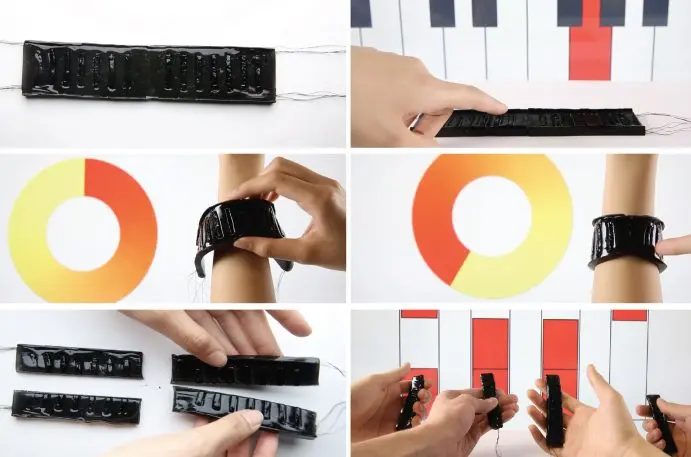It’s impossible to forget the terrifying invincibility of the T-1000 liquid metal robot in Terminator 2. Even when shot with bullets, or split apart by explosions, the robotic goop would slowly form itself back together, healing itself anew.
[Image: courtesy Morphing Matter Lab/Carnegie Mellon University]A team of researchers from the Islam Research Group, Morphing Matter Lab at Carnegie Mellon University, and Kawahara Lab at the University of Tokyo have created a material that’s functionally similar to that sci-fi liquid metal. Made out of plastic, it’s called the Self-Healing UI. It’s a self-healing polymer that’s laced with carbon nanotubes capable of conducting current, which the researchers have used to build self-repairing computers, controllers, and even robot arms. Their inventions can literally be sliced apart, then stuck back together again (no glue, solder, or sutures required), which has major implications for building flexible, durable electronics for our bodies and environments.
[Image: courtesy Morphing Matter Lab/Carnegie Mellon University]The self-healing polymer itself is a known technology, and you can actually buy some for yourself since it’s marketed as a child’s putty toy. Called polyborosiloxane (or PBS), its structure is built of boron and oxygen bonds. Slicing the putty breaks these bonds. Placing two pieces of putty side by side encourages the bonds to reform.
The researchers created their own PBS, then added carbon nanotubes—the sub-microscopic wonder structures known for superb electrical conductivity along with all sorts of other unique properties. These nanotubes provide a wiring system to the self-healing PBS, which upgrades the putty to a modern electronic that can carry current and embedded sensors.

To prove the technology, the researchers constructed all sorts of incredible demos. In one, they built a piano keyboard out of the putty for one person to play. Then they cut the keyboard into four, allowing the instrument to be shared, the keys divided between four users. In another, a robotic arm is filled with pneumatic (pressurized motor) chambers, which allows it to flex from a snake into a “C” like a muscle. Sliced and stuck back together, the arm still works—even if you accidentally stick part on backwards. Finally, the team developed a sort of high-tech friendship charm. It’s a heart that can be broken into two. It recognizes the break when it’s made. And of course, it can be stuck back together again.
[Image: courtesy Morphing Matter Lab/Carnegie Mellon University]
While the healing appears instantaneous on video, the self-repair process can actually take several hours. But for a gadget you’d wear, or would be placed inside a building, the process takes place continuously, so it would never reach a catastrophic, T-1000-blowing-to-bits failure in the first place.
Into the future, Carnegie Mellon assistant professor Lining Yao says the team would like to combine Self-Healing UI with 3D-printed morphing materials to allow objects to be flat-packed, then pop into a 3D shape when heated. “We can have a [product] automatically self-fold and self-heal to create seamless assistive wearables on the body,” Yao says. And for buildings, she suggests that we’ll have floors and walls that can detect their cracks and self-heal. “You can imagine kids can draw, mold, and sculpt on the wall, even control lights and play games through the wall,” Yao says. “Overnight, the wall will recover and heal back to normal.”
The future is most certainly looking goopy.
Recognize your brand’s excellence by applying to this year’s Brands That Matter Awards before the early-rate deadline, May 3.